
The challenge with shoulder rest and chinrest |
The Possibility of Playing Viola While Considering Physiology
As a viola teacher, I have been focusing for 20 years on the possibility to play viola while considering physiology. Through my experience with Alexander Technique and Yoga, I developed my perception on all angles and levers, which truly «make» the music. The right angles to play violin and viola have turned out to be particularly important. Following my juror job with «Jugend Musiziert» on a regional level, I realized that many musically talented children were literally hindered in their progress, not respecting the physiologically good angles.
When asking, I realized that the question of the chin holder and choice of the shoulder rest was answered empirically, rather than following a system. Following the saying, «just do it the way I do it» handing every student the same tools, which we may have used for years as a teacher, (even if successfully) to the principle, «beginners will be fine using cheaper models», to the complete negligence of the topic, everything was covered.
Point of Contact between Instrument and Player
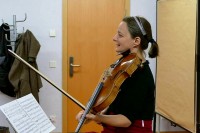 One starting point is particularly important to me. I believe that the first point of contact between instrument and player should be the point between lower bout and collarbone, and that ALL helping tools should relate to this point. Following this position, which is well known in historical performance practice, where such «crutches» aren’t used, it becomes obvious that the gap between shoulder and instrument, and the gap between upper bout and the player’s chin should be filled through the chin holder. These requirements alone already have pretty noticeable effects and disqualify more than half of the holders available on the market.
One starting point is particularly important to me. I believe that the first point of contact between instrument and player should be the point between lower bout and collarbone, and that ALL helping tools should relate to this point. Following this position, which is well known in historical performance practice, where such «crutches» aren’t used, it becomes obvious that the gap between shoulder and instrument, and the gap between upper bout and the player’s chin should be filled through the chin holder. These requirements alone already have pretty noticeable effects and disqualify more than half of the holders available on the market.
Assuming that contact is necessary between wood and human bones, the first to leave the market are the super high shoulder rests and the slightly barbaric looking metal prostheses. These models were based on the idea, that an instrument will have the most resonance if it barely touches the player. I find this a senseless philosophy, for my instrument would apparently sound best in its case, hanging on a hook. I also assume that each body has its own sound, and that the player can’t just form the sound through bowing and fingering. Only the symbiosis of the body with the instrument connects the player on a personal level, to form an emotionally intriguing sound.
Based on these essential requirements, the following features are important when choosing the rest:
Width:
The shoulder rest must be tweakable in width, so that it can be adjusted to the instrument's corpus. Most rests on the market have this feature, although not always to the extent I’d wish for. The part where the rest is curved, is adjusted and tightened through screws, and it matters whether this happens to the right or the left.
Height:
The height must be adjustable independently on both sides, and designed in a way that even at the lowest setting, the screw doesn't touch and scratch the instrument's bottom (which often is the case). If this is impossible, the player is forced to adjust the rest higher than useful.
Curvature:
The rests are most often curved in a way, that they may ideally be placed perfectly on the player's shoulder. However it would often be necessary, to move the curvature to the right or left, to adjust the placement of the head, depending if the player wants to use a middle, or left placed chin holder (see below). If this is impossible, the player tends to try and adjust the shoulder to the rest, instead of vice versa, to compensate.
Angle:
On many of the cheaper models, the angle may not be adjusted at all. This feature might raise the price dramatically; however, without this feature, the holder is not really useful. For the following reason:
The instrument must be held horizontally, and the player's thorax is mostly vertical. If the rest can only be fixed parallel to the bottom of the instrument, a gap results between thorax and the rest's outer side. The player will now attempt to fill this gap by raising the shoulder, or even by rotating the underarm, to feel that the instrument is safely held.
This scenario often leads to too much tension in the right shoulder and, because the body likes to work symmetrically, holding this shoulder too high as well. In such a case, the teacher will typically suggest that the right shoulder should remain lower – probably without success, because the root of the problem is to be found on the left side.
Material:
The rest should «sound well», but not just on its own. I suggest to test playing a new instrument without rest or chin holder, and only on empty strings. All additionally added aids should change the sound as little as possible.
This experiment must be conducted with the student! It is remarkable to see how much the sound changes, and how much «freedom» it may lose.
That's why I stay away from plastic rests (for example Kuhns, Pacato) and prefer rests made out of wood or carbon fiber.
A few rests available on the market, and their advantages/disadvantage
![]() Kuhn Kuenstler:
Kuhn Kuenstler:
Good rests made out of wood and light foam coating, can be adjusted
in angle, width and height (ca. 80€).
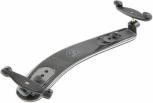 Pedi Carbon:
Pedi Carbon:
My current rest, very light, doesn't seem to impact the overtone
spectrum negatively (ca. 80€).
 Augustin:
Augustin:
Unfortunately, the angle can't be changed, however it sounds
beautiful and is very light (ca. 60€).
 Pirastro:
Pirastro:
Made out of wood, personally adjustable, I haven't tested this costly
rest myself, however it is very light and sounds excellent (ca. 300€).
Chin Holder Placed in the Middle
As a small person, who has always played viola, I quickly learned that it is easier to play with a chin holder that is placed over the tailpiece, (short: a middle chin holder), than with a chin holder placed on the left. There's also a half variant, where the chin holder still touches the tailpiece, however the curve still stays on the left side. Depending on the corpus size and instrument, I recommend the left, half middle, or middle chin holder.
The smaller the player and the larger the instrument, the more the musician will benefit from a middle chin holder. In my experience, even tall instrumentalists have benefitted from using a middle chin holder. I am meanwhile an advocate for the middle or half middle chin holder.
Form and Sound
The form needs to fit the player's jaw joint particularly well, shouldn't have any hard edges, and have an overall smooth, oval surface. Many chin holder have a hump, with some kind of curve behind. That is problematic, as this feature leads players to hold their head too up front, to reach the bump with the chin, then pulling back the head, which results in strong neck tension. That's why I plead for models with a relatively flat form, not too deep of a curve, and a smooth edge – still considering the player's jaw joint form of course. Important here as well is that the chin holder is made out of well sounding material, as it shares a larger contact surface with the instrument.
A few beginners' chin holders are made of plastic, which I advise against.
There’s a chin holder by Wittner, which is made of very pleasant plastic, however it doesn’t match a wooden chin holder in terms of sound. However, the model is adjustable in height and angle.
Physiological Peculiarities
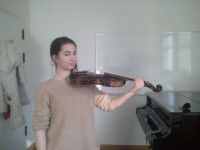 Many young players have long necks. They are often advised to use too high rests due to a lack of selection on the market, which has a tremendous impact on their technique, freedom of movement and sound.
Many young players have long necks. They are often advised to use too high rests due to a lack of selection on the market, which has a tremendous impact on their technique, freedom of movement and sound.
Players with long necks must choose a height adjustable chin holder, which unfortunately is still a relatively rare product.
Apart from the Wittner chin holder, which won't suffice with its adjustable height, there's a chin holder with screws, placed on the underside. It is made by violin maker Reiner Wilfer, but may also be ordered with other violin makers. However, I couldn't find it on online platforms yet. This model exists in the middle variant, however also as a half middle and potentially in a left variant. Various woods are offered.
In order to determine the right height, I calculate as follows: The player puts the instrument in its common playing angle, on to the collar bone. The player then turns the head slightly to the left, without bending the head (just as if saying no). I give two fingers width of wiggle room to the bottom. After the «no» comes the «yes»: the player nods briefly, still with the head turned to the left, then lands softly on the chin holder, without further adjustments, and without pulling the head back again.
Chin Holder Screws
The chin holder screws, typically double threaded screws, are easily loosened or tightened with the small metal pins, obtainable with violin makers. However, they are mostly made of metal, and carry the sound vibrations quite slowly. If you value a fast sound carrier, titan screws may be worth the investment (ca. 40€); in my opinion, these are almost always worth the money. They are just as easy to install as the common screws, and always make the instrument respond easier, with both students and professional players. That's why I wish that chin holder manufacturers would use fewer screw types, which require a toolbox to installing or removing the chin holder.
These paragraphs shall serve as an orientation and buyer's guide. However, they may not replace the opinion of an experience instrumental teacher. Still, I hope to have inspired a few colleagues and students with this article.
Youtube channel by Marion Leleu:
https://www.youtube.com/channel/UClc7EBk1e3RhZ1IONeXjBOw
Interesting web links:
The French violist Marion Leleu studied at the CNSM in Lyon and later with Tabea Zimmermann in Frankfurt/Main.
She worked for many years as an orchestral musician at the Hamburg State Opera and the Kammerakademie Potsdam. Also, among others, as a guest musician in other ensembles such as the Chamber Orchestra of Europe, the Ensemble Modern, the Bavarian State Opera, the Dresden State Opera and the 'Akademie für Alte Musik' Berlin.
The stage experience she gained there has been passed on to the UdK Berlin since 2008 and to the Hans Eisler Hochschule (Bach Gymnasium) since 2017.
Her passion is the pedagogy and psychological support of other musicians in order to help them to achieve their best possible performance.
Another focus of her pedagogical work is the analysis of movement and placement from a physiological point of view.
Photos: Marion Leleu

(1770-1831)
3 Duos op. 26, for violin and viola, edited by Bernhard Päuler
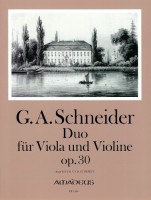
(1770-1839)
Duo op. 30, for viola and accompanying violin, edited by Bernhard Päuler

Sonata for viola and piano, edited by Timon Altweg
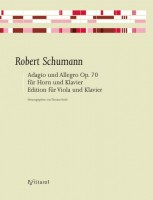
Adagio and Allegro, op. 70, for viola and piano, edited by Thomas Riebl
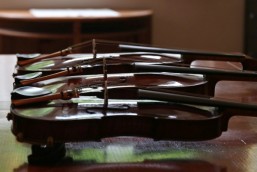
Viola Handbook by Barbara Gschaider:
Body Size and String Length
I was in love with the idea that the viola sound emerges from a mystery, that certain violas are just miraculously easy to play. This opinion is still very common nowadays.
» to the blog
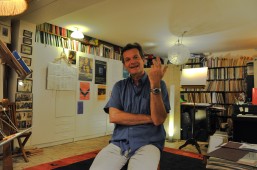
The viola at university: Rising Demand
In contrast to music school students, professionals need to explore the question of character and type: «Violists are less hurried, less competitive and aren’t looking for the spotlight... In the ensemble, violists take on the intermediary and connecting role», says Nicolas Corti, viola professor at the Zurich University for the Arts.
» to the blog

Georg Philipp Telemann was one of the most important composers of the Baroque period. He contributed innovative impulses to the development of music and significantly changed the musical world of the early 18th century
» to the blog
 Do you don't want to miss any news regarding viola anymore? Our monthly viola news letter will keep you informed.
Do you don't want to miss any news regarding viola anymore? Our monthly viola news letter will keep you informed.» Subscribe to our viola letter for free
 Visit and like us on Facebook.
Visit and like us on Facebook.» Music4Viola on Facebook
